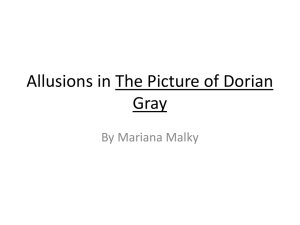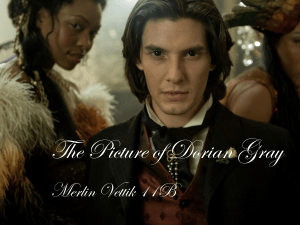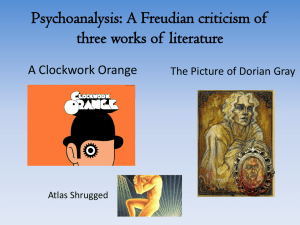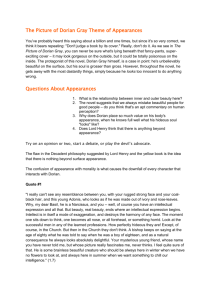The Picture of Dorian Gray
advertisement
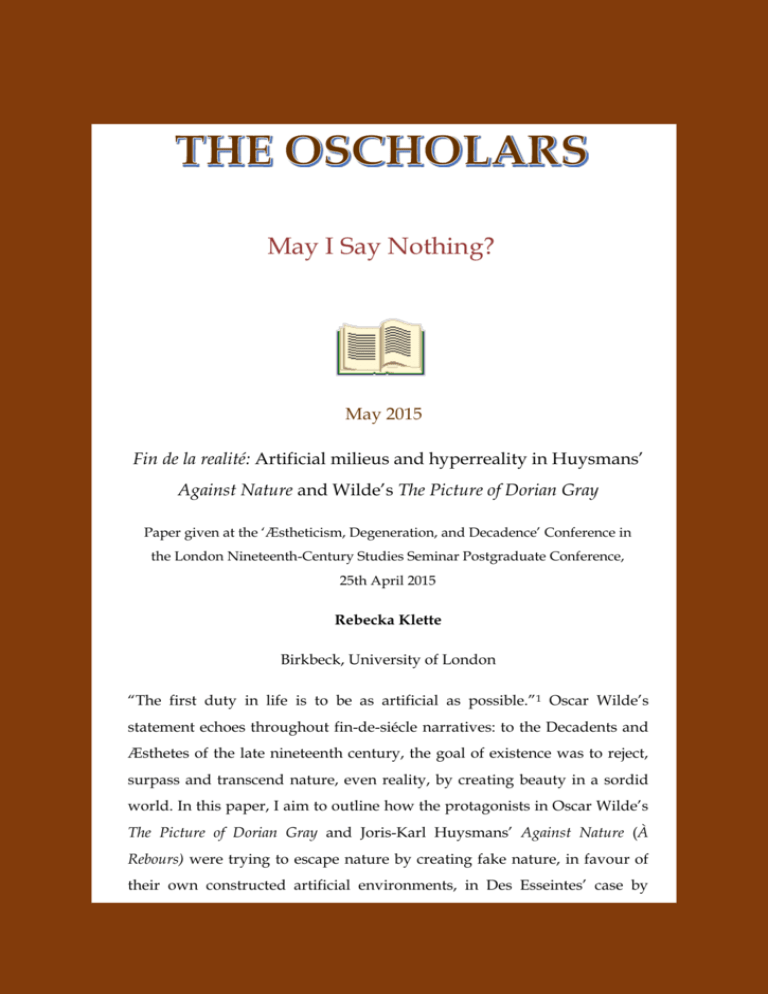
May I Say Nothing? May 2015 Fin de la realité: Artificial milieus and hyperreality in Huysmans’ Against Nature and Wilde’s The Picture of Dorian Gray Paper given at the ‘Æstheticism, Degeneration, and Decadence’ Conference in the London Nineteenth-Century Studies Seminar Postgraduate Conference, 25th April 2015 Rebecka Klette Birkbeck, University of London “The first duty in life is to be as artificial as possible.”1 Oscar Wilde’s statement echoes throughout fin-de-siécle narratives: to the Decadents and Æsthetes of the late nineteenth century, the goal of existence was to reject, surpass and transcend nature, even reality, by creating beauty in a sordid world. In this paper, I aim to outline how the protagonists in Oscar Wilde’s The Picture of Dorian Gray and Joris-Karl Huysmans’ Against Nature (À Rebours) were trying to escape nature by creating fake nature, in favour of their own constructed artificial environments, in Des Esseintes’ case by surrounding himself with artifice, and in Dorian’s case by actually replacing himself with Art. I will argue that these artificial environments should be conceived of as simulacra, as the sign that has replaced the signified, rendering the world outside it irrelevant, and the artificial milieu hyperreal. The boundaries between authentic and fake, between artificial and organic, between copy and original are constantly transgressed, and the artificial world appears to be “more real” than the world itself. I aim to show that Wilde and Huysmans appear to be anticipating Jean Baudrillard’s theory of hyperreality, in which representation becomes more real than the represented object, becoming simulacra, a copy without an original. This is, however, not to be interpreted as an anachronistic expression of postmodernism, but rather what Baudrillard calls simulacra of the second order, which he relates to nineteenth-century media mass-production of signs as commodities (artifice) imitating, preceding and replacing the original (nature).2 The protagonist of Against Nature (1884), Duc des Esseintes, has retreated from urban society to a secluded mansion in the suburbs of Paris, where he devotes himself to the cultivation of artifice through the enjoyment of beautifully adorned books, art, stimulants and narcotics, exotic and fake flowers, perfumes, and rare gems. Des Esseintes’ goal is to transcend, replace, and simulate nature by surrounding himself with the artificial: he attempts to create an artificial world within his home, but does not attempt to imitate or reproduce nature, but to annihilate it, “seeking the copy or the mechanically produced, not as a substitute for the natural but in preference to it.”3 He paints his walls in colours that will appear more vibrant in artificial light, admiring perfume for its capability to imitate and surpass natural scents, even simulating rivers by pouring coloured essences into his aquarium, enabling him to enjoy “all the sensations of a long sea-voyage, without ever leaving home.”4 Des Esseintes creates in his home an artificial world, so that he doesn’t have to return to the real world, regarding imagination as superior to, and more real than, actual experience: perceiving the urban cityscape as alienating and æsthetically displeasing, he attempts to escape to nature - but not the untouched nature of the Romanticists, but an imagined nature; a refined, processed and artificial nature. When Des Esseintes becomes tired of fake flowers imitating real ones, he instead longs for “natural flowers that would look like fakes.”5 His desire for the artificial has progressed from Baudrillard’s first stage of sign order (in which the copy reflects a profound reality, perfectly attempting to copy the flower), to the third stage of sign order, in which the copy masks the absence of a profound reality, playing at being an appearance.6 Similar to my argument, Françoise Gaillard differentiates between the “realist illusion” and the “decadent imitation” in her essay on Á Rebours,7 where the former aims to appear a true representation, while the latter emphasises its artificiality and falsity, “a copy that announces itself as copy”.8 By seeking real flowers that look fake, and fake flowers that look real, the real and the fake can no longer be separated, rendering them simultaneously natural and artificial. By preferring real flowers that appear to copy artificial flowers, the copy has preceded the real to become simulacra, or as Galliard argues, resulting in “a naturalized artifice and an artificial nature”.9 Des Esseintes also decides to gild and encrust a live tortoise with jewels: by encasing nature in artifice, he undermines it, rendering nature an imitation of itself, a copy without an original essentially, hyperreal. The turtle can be read as representing Baudrillard’s second level of sign order,10 in which the sign perverts and masks a profound reality, ultimately erasing it: the tortoise dies, unable to “bear the dazzling luxury imposed upon it”.11 To Oscar Wilde, Life imitates Art, rather than Art imitating Life; this can be interpreted as an early form of the theory of Hyperreality, in which Art (understood as Sign) precedes life, becoming more real than reality itself. The New Hedonism that Lord Henry and Dorian advocates in The Picture of Dorian Gray (1891) seeks to recreate life artificially, and “It was the creation of such worlds as these that seemed to Dorian Gray to be the true subject (…) of life”.12 By stating that “Being natural is simply a pose”,13 Lord Henry posits nature as merely another act of artifice, another performance or simulation: he even claims that he loves acting because “It is so much more real than life.”14 Wilde’s cult of artifice is most apparent in chapter 11, recounting how Dorian takes up the study of perfumes, music, and jewels; a clear homage to Á Rebours. To Dorian, materiality implies immortality: by trading places with his own portrait, he has himself become a work of art, an artificial commodity interchangeable with commodities in much the same way he changed places with the portrait. Dorian seeks to gain the ontological stability and essence of the material object, and gains it through the portrait - the portrait changes and decays, while Dorian remains in a fixed state of youth and beauty. While he influences his portrait through his depraved actions, he is simultaneously under the influence of “The Yellow Book”, unanimously understood by scholars to be Huysmans’s Á Rebours. The book seems to precede him, much like Kostas Boyiopoulos argues that the portrait of Dorian seems to precede Dorian himself.15 This renders Dorian a mere copy of the original character: “The whole book seemed to him to contain the story of his own life, written before he had lived it.”16 The idea that Life imitates Art is again apparent: Dorian (Life) imitates Des Esseintes (Art), while the organic portrait imitates the artificial Dorian, causing the liquidation of all referentials.17 The metamorphosis is twofold: the portrait ceases to be sign, and Dorian becomes sign; the boundaries between sign and object has imploded, and the “real” Dorian is simultaneously the portrait and the individual. The protagonists isolate themselves from the real world in different ways: while Des Esseintes physically removes himself from Parisian society to retreat to his villa, Dorian hides away his portrait (his “true” self) in the attic, while he himself - as artefact, as commodity and as simulacra - roams around London. Dorian is thus turning every space he inhabits into an artificial one, rendering London a sort of giant Wünderkammer, in which he is one of the collected artefacts. Des Esseintes prefers the copy to the real, wishing the real to appear as fake and the fake as real; to Dorian, everything in the world is copy, mere manifestations of abstract ideals - nothing is real, so everything must be equally real and equally unreal, creating a kind of ontological inflation of Truth. Dorian and Des Esseintes prefers signs over the signified, not as a substitute, but because the sign appears to be more real, or equally real, compared to the reality it signifies, moving from the realm of realism into hyperrealism. This artificial projection of civilised society, in turn, starts to precede the environment it supposedly mimics, and the need to experience “true” city life becomes redundant. Dorian seem to regard the city spaces of London which he frequents as “equally real” compared to the æsthetic habitats which he, Lord Henry, and Basil have constructed for themselves the artificiality of the city is recreated in a separate private space, rendering “The public spaces of the city (…) colonised to the interior artistic vision of the subject.”18 Rather than a wish to return to “true” nature, nature could now be tamed and artificially reproduced,19 refined and moulded to nineteenth century preferences: the artificial milieu as simulacrum becomes a condensed city, a sort of decadent doll house or Victorian folly. By projecting his personality onto his surroundings, he transforms environment from a passive organic state to an artificial, ever-morphing performance, as easily changed as the changing of a theatre coulisse and scenery. As Sign replaces, erases and renders its referent redundant, the artificial world annihilates the nature it was supposed to represent. While representation is sign aspiring to appear as reality, the artificial environment is reality aspiring to appear as sign,20 trying to supersede and erase reality - becoming Hypernature, becoming hyperreal. Bibliography Baudrillard, Jean, Simulacra and Simulation, trans. by Sheila Faria Glaser (Michigan: The University of Michigan Press, 1994) Boyiopoulos, Kostas, ‘Simulation in The Picture of Dorian Gray: Echoing Hamlet, Anticipating Baudrillard, and the Comparative.’ Comparative Critical Studies 11.1 (2014) 7-27. Cook, Matt, London and the Culture of Homosexuality, 1885-1914 (Cambridge: Cambridge University Press, 2003) Eco, Umberto, Travels in Hyperreality (London: Pan Books, 1987) Gaillard, Francoise, “A rebours ou l’inversion des signes.” in L’esprit de décadence, Colloque de Nantes 1, (Paris: Libraire Minard, 1980) 129-40 (131), cited in Spackman. Huysmans, Joris-Karl, Against Nature, trans. by Robert Baldick (London: Penguin Books, 2003) McGuinness, Patrick, ‘Introduction’ in Joris-Karl Huysmans, Against Nature, trans. by Robert Baldick (London: Penguin Books, 2003) Olalquiaga, Celeste, The Artificial Kingdom: A Treasury of The Kitsch Experience (London: Bloomsbury, 1998) Spackman, Barbara, ‘Interversions’ in Perennial Decay, ed. by Liz Constable, Dennis Denisoff, and Matthew Potolsky (Philadelphia: University of Pennsylvania Press, 1999), pp. 35-49. Wilde, Oscar, ‘Phrases and Philosophies for the use of the young’ (1894) in Art and Decoration (London: Methuen & Co, 1920) Wilde, Oscar, The Picture of Dorian Gray (London: Wordsworth Classics, 2001) (PDG) To return to the Table of Contents of Æstheticism, Degeneration, and Decadence, please click here To return to our home page, please click here To return to THE OSCHOLARS former home page, please click here Oscar Wilde, ‘Phrases and Philosophies for the use of the young’ in Art and Decoration (London: Methuen & co, 1920), p. 1. 2 Jean Baudrillard, Simulacra and Simulation, trans. by Sheila Faria Glaser (Michigan: The University of Michigan Press, 1994), p. 6. 3 Patrick McGuinness, ‘Introduction’ in Joris-Karl Huysmans, Against Nature, trans. by Robert Baldick (London: 1 Penguin Books, 2003), p. xxxi. 4 Joris-Karl Huysmans, Against Nature, trans. by Robert Baldick (London: Penguin Books, 2003), Hereafter referred to as AN, p 21. 5 AN, p. 83. 6 Jean Baudrillard, Simulacra and Simulation, trans. by Sheila Faria Glaser (Michigan: The University of Michigan Press, 1994), p. 6. 7 Françoise Gaillard, “A rebours ou l’inversion des signes.” in L’esprit de décadence, Colloque de Nantes 1, (Paris: Libraire Minard, 1980) 129-40 (131), cited in Barbara Spackman, ‘Interversions’ in Perennial Decay, ed. by Liz Constable, Dennis Denisoff, and Matthew Potolsky (Philadelphia: University of Pennsylvania Press, 1999), pp. 35-49, p. 37. 8 Barbara Spackman, ‘Interversions’ in Perennial Decay, ed. by Liz Constable, Dennis Denisoff, and Matthew Potolsky (Philadelphia: University of Pennsylvania Press, 1999), pp. 35-49, p. 44. 9 Spackman, p. 43. 10 Baudrillard, p. 6. 11 AN, p. 49. 12 Oscar Wilde, The Picture of Dorian Gray (London: Wordsworth Classics, 2001), p. 105. Hereafter referred to as PDG. 13 PDG, p. 7. 14 PDG, p. 65. 15 Kostas Boyiopoulos, ‘Simulation in The Picture of Dorian Gray: Echoing Hamlet, Anticipating Baudrillard, and the Comparative.’, Comparative Critical Studies 11.1 (2014) 7-27 (p. 13). 16 PDG, p. 102. 17 Baudrillard, p. 2. 18 Matt Cook, London and the Culture of Homosexuality, 1885-1914 (Cambridge: Cambridge University Press, 2003), p. 96. 19 Celeste Olalquiaga, The Artificial Kingdom: A Treasury of The Kitsch Experience (London: Bloomsbury, 1998), p. 13. 20 Eco, p. 52.
